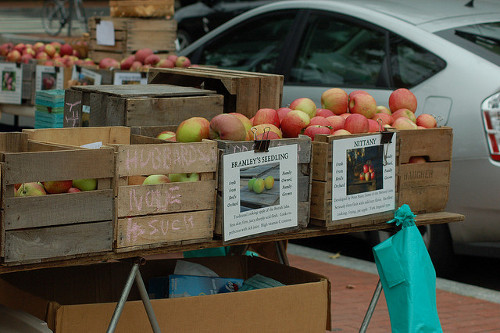When perusing the produce section of my local supermarket, my heart sinks upon reaching the pristine stacks of apples. There’s a few typical varieties like Red Delicious, Golden Delicious, Granny Smith, and maybe Gala or Fuji. They’re all uniform in shape, size, and color, and coated with a shiny, unnatural feeling wax. If you’re lucky, there will be as many as 12 different varietals at your market. But they will all be familiar to you, and they will all be of a standard appearance and similar taste (except for, maybe, the Granny Smith). You’re probably thinking that this is normal, so what exactly is the problem? The problem is this: such boring standardization is anything but true to the basic nature of an apple.
When Johnny Appleseed roamed the American countryside scattering seeds along the way, his intentions were boozy. Cider was the drink of choice in the colonies, and he hoped to encourage settlement by having apple orchards ready to go when people arrived. Surely some of these were good eating apples as well, but planting an apple seed does not guarantee an apple worth biting into. Much like people, apple seeds are not copies of their parent—they’re randoms, hoping to increase the chances of survival no matter where the seeds are dropped by a bird or animal. The only way to create a copy of a specific apple tree is by grafting, a technique still used today. Every Pink Lady apple you eat was picked from a tree that was grafted from the original Pink Lady tree or one of its relatives. So how did we end up with so few choices?
Commercialization, of course. When the grocery business became a nationwide endeavor, farmers needed to have a few star varietals to market to consumers. This led to a whittling down of glorious apple options and to the mass marketing of the dreaded Red Delicious, among others. This also meant that many great cider apple varieties were lost, especially once prohibition set in. The U.S. quickly went from a country with thousands of varieties that varied by region to a country with a few kinds of apples that were available everywhere. And while there are heirloom apples that are good for baking, winter keeping, or cider-making, most supermarket apples are bred solely for fresh eating and pretty display.

But that doesn’t come close to highlighting the rainbow of apples that still exist today just out of eyesight. Think about it: apples too big to bite into, apples the size of a silver dollar. Red, green, brown, or nearly black skin; bright pink flesh. Thin and thick skinned, shiny and russet. Lumpy, pear-shaped, perfectly round. Pretty and surprisingly ugly, crunchy or soft. Sour, sweet, astringent, bitter. There are apples with tropical notes, and apples that aren’t sweet at all. It’s one of the most botanically diverse fruits we’ve ever encountered, with over 17,000 known varieties grown between 1623 and 2000.
Today, we’ve whittled that down to a little over 5,000. It’s sad to see that the number has shrunk so drastically and so many kinds are lost, but sadder still to know that little more than 1 percent of these varieties are making it to market. If you’re anything like me, you long to taste as many weird apples as you can get your hands on. And unless you live near an old school apple orchard or have a quirky neighbor, your best bet for accomplishing this is visiting a good farmers’ market. You’ll still see many of the standard varieties (of better quality), but most small-scale apple farmers have a few interesting apples growing in their orchards, sometimes leftover from the previous generation or two. If you don’t hit the heirloom apple jackpot, start asking questions. Farmers may have some apples on their property that they don’t bring to market for fear they won’t sell, or they might know about an apple goldmine nearby. If you live in a climate that’s good for apple growing, start exploring. Since apple trees can easily live to be over 100 years old, trees can still be found growing on long-abandoned properties, especially in the Northeast.
Hundreds of heirloom apple varieties like Pitmaston Pineapple, Ozark Gold, and Knobbed Russets can be found, they just take a little bit of looking. Look beyond the pretty stacks of shiny supermarket specimens to the nobby but totally delicious apples still growing in America’s countryside. A cornucopia of weird apples await you.
Laurel Randolph is a food and lifestyle writer hailing from Tennessee and living in Los Angeles. She enjoys cooking, baking and candlestick making. Tweet at her face: @laurelrandy.
Orchard photo by Francesco Minchiatti CC BY-SA
Market photo by CC BY-SA